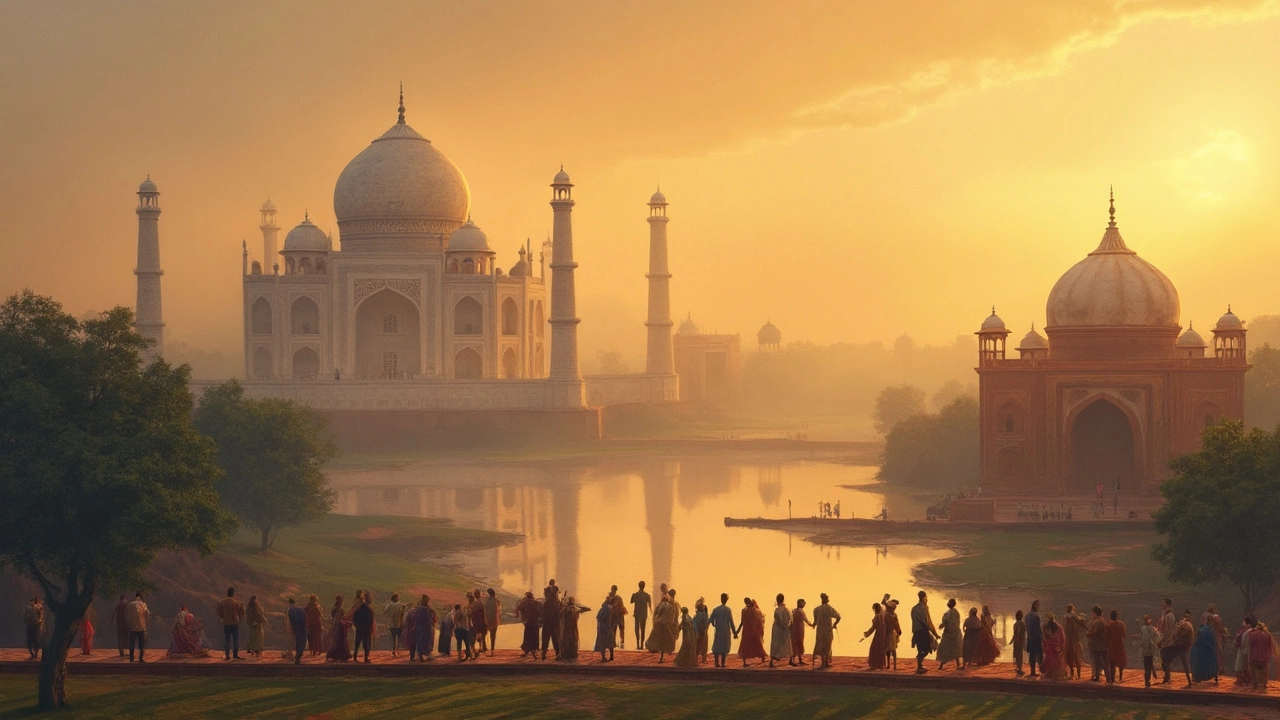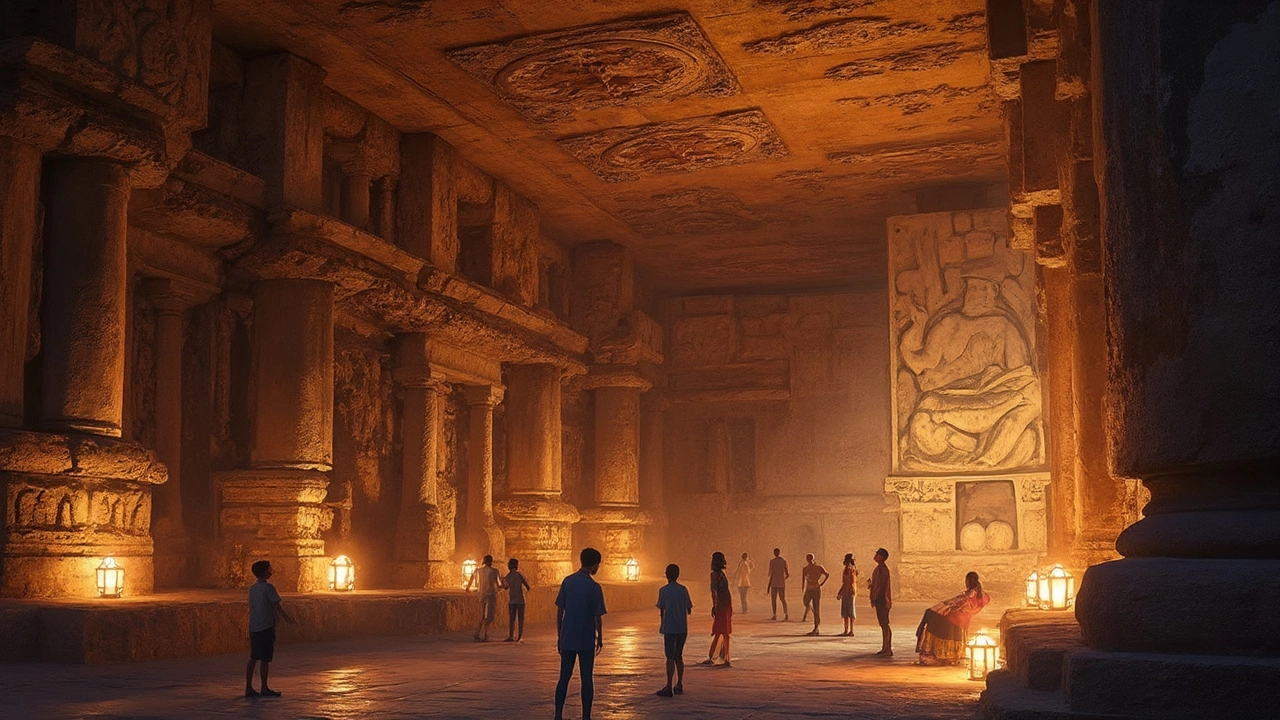India Ranks High in World Heritage Sites: Discover Its Treasures
 Apr, 15 2025
Apr, 15 2025
Ever wondered where India stands when it comes to World Heritage Sites? Well, brace yourself for some pretty exciting news. India has carved out quite a niche in the global rankings, proudly holding one of the top spots with a remarkable 40 UNESCO World Heritage Sites. Not just that, but this mix of cultural and natural landmarks really highlights the country's diverse tapestry.
From the timeless beauty of the Taj Mahal to the lush landscapes of Kaziranga National Park, India’s heritage sites aren't just places to see— they’re stories waiting to be told. These sites not only reflect the country’s glorious past but also its commitment to preserving these wonders for future generations. Next time you plan a trip, consider adding a heritage site or two to your itinerary—it could be the experience of a lifetime.
- India's Rank in World Heritage Sites Globally
- Famous World Heritage Sites in India
- The Cultural Significance of These Sites
- Tips for Visiting India's Heritage Sites
- Future Prospects for New Heritage Listings
India's Rank in World Heritage Sites Globally
India's impressive collection of World Heritage Sites has earned it a spot in the top 10 countries globally with the most UNESCO sites. As of 2025, India proudly showcases 40 remarkable sites, making it a hotspot for culture and history buffs. This blend of cultural and natural wonders puts India just behind countries like China and Italy, which hold even higher numbers.
What makes India’s ranking so fascinating is the sheer diversity of its sites. From ancient temples and historic forts to breathtaking landscapes, these locations reflect the wide-ranging beauty and history of the nation. Not to forget, each site is a piece of a larger narrative, spotlighting different aspects of India's past and its ecological riches.
To put it in perspective, here's a breakdown of India's UNESCO sites by type:
| Type | Number of Sites |
|---|---|
| Cultural | 32 |
| Natural | 7 |
| Mixed | 1 |
These numbers aren't static; in fact, India constantly strives to increase these figures. Each year, proposals for new sites are submitted, with the hope that more places will gain international recognition. The government and preservationists work tirelessly to ensure that these sites are well maintained and worthy of their heritage status.
Overall, India's rank in the realm of heritage sites is not just a matter of numbers. It's a testament to the country's dedication to preserving its past while paving the way for future generations to enjoy these treasures.
Famous World Heritage Sites in India
India is like a kaleidoscope when it comes to its World Heritage Sites, offering a glimpse into the country's rich and varied history. If you were to take a tour around India, you'd find each site has a story that goes way back in time, starting with the famous Taj Mahal in Agra. Built by Emperor Shah Jahan in memory of his wife Mumtaz, this ivory-white marble mausoleum is an epitome of love and Mughal architecture.
Then there's the majestic Red Fort in Delhi, a stunning piece of Mughal design that's been standing strong since 1648. It's not just a fort; it was the main residence of the emperors of the Mughal dynasty for about two centuries. And, of course, it's a must-visit if you want to dive deep into India's historical path.
Don't forget the Ajanta Caves in Maharashtra! This series of rock-cut caves is like a masterpiece gallery etched into the hillside. Filled with paintings and sculptures depicting tales of Buddhist life, it's like walking through ancient art that dates back as far as the 2nd century BC.
- Ajanta Caves - A showcase of ancient Indian art and culture.
- Qutub Minar - A towering symbol in Delhi, showcasing Indo-Islamic architecture.
- Sun Temple at Konark - A 13th-century marvel dedicated to the Sun God.
- Khajuraho's Temples - Celebrated for their intricate sculptures and carvings.
- Kaziranga National Park - Home to the largest population of the Indian one-horned rhinoceros.
And if you're into mixing nature with heritage, the Great Himalayan National Park with its unique biodiversity is a whirlwind of flora and fauna that's sure to leave you awestruck. India sure knows how to blend cultural marvels with breathtaking natural beauty.
So, whether you're a history buff or a nature enthusiast, India's list of World Heritage Sites covers it all. Remember, each site is a treasure waiting to be discovered, offering insights into India's incredible past, architecture, and biodiversity.

The Cultural Significance of These Sites
India's World Heritage Sites aren't just about stunning views—they’re living, breathing symbols of the country’s cultural and historical journey. Each site is like a chapter in a massive storybook that reveals India’s rich and diverse past.
Take, for instance, the fascinating Ajanta and Ellora Caves. These rock-cut temples are more than mere art; they tell stories of ancient India’s cultural mingling, where Hindu, Buddhist, and Jain influences splendidly coexist. It’s like taking a step back in time to watch how different beliefs were expressed through intricate carvings and paintings.
Then there's the iconic Taj Mahal, a masterpiece built in memory of love, which isn’t just a personal testament of Emperor Shah Jahan to his beloved Mumtaz Mahal, but a symbol of the pinnacle of Mughal architecture and the interweaving of Indian, Persian, and Islamic styles.
Let's not forget the Sun Temple at Konark, representing the zenith of ancient Indian architecture and astronomy. This UNESCO site goes beyond aesthetics; it’s a testament to India’s advanced understanding of engineering, geometry, and cosmic elements.
These sites also play a big role in educating and connecting people to India’s deep-rooted traditions. The grandeur of cultural landmarks like these inspires countless visitors to appreciate the country’s craftsmanship and historical narratives, promoting cultural awareness that goes beyond mere tourism.
Tips for Visiting India's Heritage Sites
Planning a trip to India’s remarkable World Heritage Sites? You'll want to make the most out of your visit with some handy tips. First up, understand that many of these sites can get real crowded, especially the popular ones like the Taj Mahal. Try visiting early in the morning or late in the afternoon to enjoy a quieter experience.
Next, don’t forget the power of a good guide. A knowledgeable local guide can turn your visit from just sightseeing into a journey through history. They’ll share stories that truly bring the sites to life, which you won’t find in any brochure.
- Dress appropriately: Some sites, especially religious ones, have dress codes. Consider carrying a scarf or shawl which can be handy for covering shoulders or heads when needed.
- Stay sun-smart: Many locations are open areas. Wear a hat, sunglasses, and don't skip the sunscreen—believe me, you’ll thank yourself later.
- Pack light but smart: Keep a small backpack with essentials like water, snacks, and a camera. Don't forget your smartphone for snapping all those Insta-worthy shots.
- Buy tickets in advance: Some places offer online booking, which can save you time from standing in long queues.
If you’re hopping across different sites, consider how travel times can add up. While India’s a feast for the senses, traffic and distances between sites can be challenging. Plan your itinerary well, giving yourself enough time to absorb each place instead of just ticking them off a list.
Finally, an important tip: respect the sites. These aren’t just tourist spots—they are cultural landmarks reflecting centuries of history. Keeping them clean and following rules ensures they remain for generations to enjoy.

Future Prospects for New Heritage Listings
India's rich tapestry of history and culture means there’s always potential for more World Heritage Sites to be added to UNESCO's prestigious list. Several sites are currently on the tentative list, eagerly awaiting their shot at the title. This lineup includes the iconic Maharashtra rock-cut caves of Ellora and Ajanta—truly awe-inspiring examples of ancient artistry.
Then there's the bustling Rann of Kutch, a saline desert sparsely populated but immensely rich in biodiversity. It’s a prime contender due to its unique ecological phenomenon and cultural festivities, like the Rann Utsav, that enchant visitors from across the world.
In recent years, there’s also been a push to recognize the architectural gems from the colonial era. Think of spots like the beautiful Victoria Memorial in Kolkata or the diverse old quarters of Lucknow. These places represent India's colonial past—an era significant in shaping the nation’s modern identity.
Efforts are underway to prepare detailed dossiers for these sites, ensuring they meet UNESCO’s criteria for Outstanding Universal Value. This process involves meticulous research and documentation, and for India, it's a serious endeavor involving not just government agencies but also the local communities who take pride in their heritage.
As India continues to bolster its standing with World Heritage Sites, the focus isn’t just on increasing numbers but also on ensuring sustainable tourism strategies. The idea is to balance conservation with accessibility, letting the world come and wander through India's rich heritage, without compromising on preserving its essence for future generations. It’s a careful dance, but one that could see India’s ranking climb even higher in the world heritage stakes.